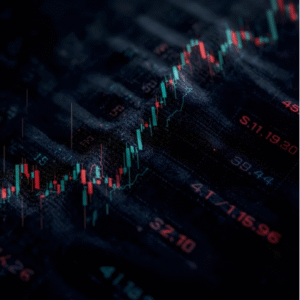Introduction to the Stock Market
The stock market is a cornerstone of modern finance, providing a centralized place where companies and investors connect. It allows businesses to raise funds by offering ownership shares to the public, while giving individuals and institutions the opportunity to grow their wealth by purchasing these shares. Beyond its role in raising capital, the stock market acts as a barometer for the overall economy, reflecting trends, growth, and market sentiment.
Through stock exchanges, transactions are conducted efficiently and transparently, creating a structured system that supports both seasoned investors and newcomers. These markets play a pivotal role in wealth creation, retirement planning, and portfolio diversification. While it may seem complex at first glance, understanding the basic principles of the stock market is a step toward gaining financial literacy and unlocking its potential benefits.

How the Stock Market Works
The stock market functions as a system where investors buy and sell shares of publicly traded companies. These transactions take place on stock exchanges, which serve as regulated platforms designed to facilitate the trading process. Companies list their shares on an exchange, allowing the public to purchase them, and in turn, the company gains access to capital needed for growth or other business purposes.
When an individual or institution buys a share, they acquire partial ownership of that company. Share prices fluctuate based on supply and demand, as well as broader market factors such as company performance, industry trends, and economic conditions. Buyers aim to purchase shares at a price they believe is fair, while sellers look to profit or minimize losses based on their expectations of future price movements.
To participate in the stock market, investors typically use brokerage accounts, which enable them to place orders for buying or selling shares. These orders can be executed in real time or scheduled for specific conditions, depending on the type of trade. The role of brokers is essential, as they connect investors to the market and provide the tools necessary for trade execution. Advances in technology have made online trading platforms widely accessible, simplifying the process for individuals.
Market participants can also analyze various metrics and data to make informed decisions about when to buy or sell. This includes studying price charts, earnings reports, and other financial statements provided by publicly listed companies. Some investors adopt a long-term approach, holding onto shares for years, while others prefer short-term trading strategies aimed at capitalizing on daily price movements

Stock prices are influenced by a continuous flow of information, including company-specific news, industry developments, and economic indicators. The stock market’s interconnected nature means that events in one area, such as changes in interest rates or geopolitical issues, can ripple through the system and impact share values.
Liquidity is another key feature of the stock market, allowing investors to quickly convert their shares into cash by selling them at the current market price. This efficiency makes the stock market an attractive option for individuals and institutions seeking flexibility in their investments.
Types of Stock Markets
There are two primary types of stock markets, each serving a distinct purpose in the trading process. The primary market is where companies issue new shares directly to investors for the first time. This process, known as an Initial Public Offering (IPO), allows businesses to raise capital by offering ownership stakes to the public. IPOs are typically managed with the assistance of investment banks, which help determine the share price and oversee the allocation of shares to institutional and individual investors.
Once the shares are issued in the primary market, they become available for trading in the secondary market. The secondary market is where the majority of stock transactions take place, as it provides a platform for investors to buy and sell shares from one another. In this market, the company that originally issued the stock does not receive proceeds from the trades. Instead, transactions occur between market participants, with prices determined by supply and demand.
Major stock exchanges, such as the New York Stock Exchange (NYSE) and NASDAQ, operate within the secondary market. These exchanges act as centralized venues where buyers and sellers can connect, ensuring fair and transparent transactions. Beyond traditional exchanges, there are also over-the-counter (OTC) markets, where securities not listed on formal exchanges are traded. OTC markets often involve smaller companies or specialized securities that may not meet the listing requirements of larger exchanges.
Different types of securities can also be traded within these markets, including common stocks, preferred stocks, and exchange-traded funds (ETFs). Common stocks represent ownership in a company and typically come with voting rights. Preferred stocks, on the other hand, usually do not include voting rights but may offer fixed dividends, making them attractive to income-focused investors. ETFs are investment funds that track the performance of a specific index, sector, or commodity and can be traded like individual stocks.

The development of electronic trading platforms has expanded access to these markets, making it easier for retail investors to participate alongside large institutions. These platforms allow investors to execute trades quickly, often at lower costs than traditional methods. With increased accessibility, the secondary market has become a critical space for maintaining liquidity and enabling efficient price discovery, further supporting the stock market’s overall function.
Major Players in the Stock Market
The stock market relies on the participation of various entities, each playing a distinct role in its operation. At the forefront are investors and traders, who actively buy and sell stocks. While investors typically focus on long-term strategies aimed at building wealth over time, traders often seek to capitalize on short-term price fluctuations through frequent transactions. Both groups contribute to the overall liquidity and dynamism of the market.
Institutional investors, such as mutual funds, hedge funds, and pension funds, manage large pools of capital and have a significant influence on market activity. Due to the scale of their investments, their buying and selling decisions can impact stock prices more noticeably than those of individual investors. Retail investors, on the other hand, consist of individuals who trade smaller amounts, often using online brokerage platforms to access the market.
Market makers are another critical group, responsible for ensuring liquidity and smooth transactions. They do this by continuously offering to buy and sell stocks at publicly quoted prices, thus narrowing the gap between the bid and ask prices. By maintaining an active presence in the market, they help prevent delays in trade execution.
Investment banks play a pivotal role, especially during events like Initial Public Offerings (IPOs). They assist companies in raising capital by underwriting and distributing new shares to the public. Their expertise in valuing companies and managing the issuance process is crucial for successfully launching stocks into the market.
Regulatory bodies, such as the Securities and Exchange Commission (SEC) in the United States, oversee the stock market to ensure compliance with laws and protect investors from fraudulent activities. These organizations enforce transparency and fairness, holding all participants accountable to established rules and standards.

Stock exchanges, like the New York Stock Exchange (NYSE) and NASDAQ, function as platforms where trading occurs. They provide the infrastructure needed for efficient market operations, from listing stocks to recording transactions. In addition, financial analysts and researchers support the ecosystem by providing insights into market trends, company performance, and investment opportunities, helping participants make informed decisions.
Technological advancements have introduced algorithmic traders, who use automated systems to execute trades based on pre-set criteria. This has added complexity to the market but also increased efficiency in trade execution. Collectively, these players shape the stock market and contribute to its continued growth and functionality.
Factors Influencing the Stock Market
The stock market is constantly shaped by a variety of elements that drive changes in stock prices and trading activity. Company-specific factors, such as earnings reports, product launches, and executive leadership changes, can have a direct impact on a company’s stock performance. Positive developments, such as higher-than-expected profits or successful new products, may attract more buyers, increasing the stock’s value. Conversely, disappointing news can trigger selling activity, leading to a drop in price.
Broader market conditions also play a role, with interest rates being a particularly influential factor. When central banks raise or lower interest rates, it can affect borrowing costs for businesses and consumers, as well as the attractiveness of stocks compared to other investments like bonds. Higher interest rates may lead to lower stock prices, as borrowing becomes more expensive, while lower rates often create a more favorable environment for stock growth.
Industry-specific developments can similarly influence the performance of certain stocks. For instance, advancements in technology or shifts in consumer preferences can drive growth in some sectors while challenging others. Changes in government policies, such as new tax regulations or trade agreements, may also have targeted effects on particular industries or companies.
Investor behavior is another significant factor in the stock market. Sentiment often drives short-term price movements, with optimism leading to higher demand and pessimism triggering sell-offs. Market trends, such as periods of bullish or bearish activity, are shaped by the collective actions and attitudes of participants. Speculation, driven by rumors or expectations, can amplify these movements.
Global events frequently affect the stock market as well. International trade tensions, geopolitical conflicts, and changes in foreign markets can ripple through the system, influencing domestic stocks. Currency fluctuations, driven by foreign exchange markets, may also impact companies with significant international operations or exports. Additionally, natural disasters or pandemics can disrupt supply chains, alter consumer behavior, and create uncertainty, all of which may influence stock prices.
Technological advancements and innovation within the financial sector can alter trading dynamics. The growing use of algorithmic trading, for example, has introduced new complexities to the market, with high-frequency transactions sometimes exacerbating volatility. Advances in data analytics and artificial intelligence have also enabled investors to process information more quickly, contributing to rapid market responses to new developments.
Risks and Benefits of Investing
Investing in the stock market provides opportunities to grow wealth and achieve financial goals, but it also comes with challenges that require careful consideration. One of the key benefits of investing in stocks is the potential for substantial long-term growth, as stock prices generally trend upward over time despite short-term fluctuations. This growth can help individuals build a solid financial foundation, plan for retirement, or fund significant life expenses. Additionally, dividends from certain stocks provide a source of passive income, making them appealing to income-focused investors.
However, the stock market is inherently unpredictable, and prices can fluctuate due to various factors, such as economic conditions, company performance, or global events. These price swings, known as market volatility, can result in substantial losses if an investor sells during a downturn. It’s important to recognize that short-term price movements do not always reflect a company’s long-term value, so patience and a clear strategy are crucial when navigating the market.
Risk tolerance varies among investors, and understanding your comfort level with risk is essential before making investment decisions. Stocks with higher growth potential often carry greater risk, while more stable investments, such as blue-chip stocks or dividend-paying stocks, may offer lower returns but come with reduced volatility. Balancing these options in a well-diversified portfolio can help manage risks effectively.
Another consideration is the impact of emotional decision-making. Fear during market declines or overconfidence during rallies can lead to impulsive actions that may harm investment outcomes. Having a disciplined approach and sticking to a plan, even during uncertain times, can improve the chances of achieving desired results.

Costs associated with investing, such as brokerage fees or capital gains taxes, can also affect returns. Investors should be aware of these expenses and seek cost-effective options, such as low-fee online trading platforms or tax-advantaged accounts like IRAs, to maximize net gains.
One way to mitigate risk is through diversification, which involves spreading investments across different sectors, industries, or asset types. A diversified portfolio reduces the impact of a poor-performing stock or sector on overall returns, providing a more stable investment experience.
While no investment is without risk, a thoughtful and informed approach can help investors balance the potential for rewards with the challenges that the stock market presents. By understanding these dynamics, individuals can make more confident decisions aligned with their financial goals and risk tolerance.see more


